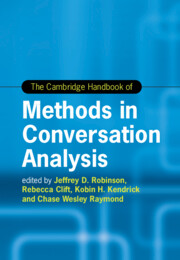Book contents
- Frontmatter
- Contents
- List of Tables
- List of Contributors
- Part I Introduction
- Part II Points of Departure
- Part III Collections
- Part IV Evidence
- Part V Avenues into Action
- Part VI Situating and Reporting Findings
- 31 Conversation Analysis across Disciplines: Connecting and Engaging through Publishing
- 32 What Do Journal Editors Look for in Publishing Conversation-Analytic Work?
- 33 Communicating Findings to Non-CA Professionals
- Part VII Looking Forward
- Appendix I Jeffersonian Transcription Conventions
- Appendix II Multimodal Transcription Conventions
- Index
32 - What Do Journal Editors Look for in Publishing Conversation-Analytic Work?
from Part VI - Situating and Reporting Findings
Published online by Cambridge University Press: 06 December 2024
- Frontmatter
- Contents
- List of Tables
- List of Contributors
- Part I Introduction
- Part II Points of Departure
- Part III Collections
- Part IV Evidence
- Part V Avenues into Action
- Part VI Situating and Reporting Findings
- 31 Conversation Analysis across Disciplines: Connecting and Engaging through Publishing
- 32 What Do Journal Editors Look for in Publishing Conversation-Analytic Work?
- 33 Communicating Findings to Non-CA Professionals
- Part VII Looking Forward
- Appendix I Jeffersonian Transcription Conventions
- Appendix II Multimodal Transcription Conventions
- Index
Summary
What happens to submissions to a journal such as Research on Language and Social Interaction which publishes close, technically sophisticated analysis of interaction? What do its editors look for? We begin by explaining why submission might be desk-rejected: it might be simply unsuitable in topic or methodology for the journal, or it might be that it is somehow not quite up to standard. Methodologically sound work on a topic of interest to the EM/CA community will pass the first hurdle and be sent out for review by knowledgeable peers. Reviewers will report on the strength of the argument, the relation of the work to what is already known, and the quality of the analysis. Most papers at this stage will receive an encouraging invitation to revise and resubmit according to the reviewers’ comments and the editors’ recommendations. The revision, to pass the next stage, should be accompanied by a closely written, collegially written commentary on what the authors have done with the reviewers’ comments. The editors will scrutinize the revision and the covering letter very carefully; if all is well, then, with one last round of very minor tidying up, all is set for publication.
- Type
- Chapter
- Information
- The Cambridge Handbook of Methods in Conversation Analysis , pp. 922 - 927Publisher: Cambridge University PressPrint publication year: 2024

